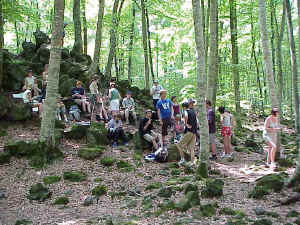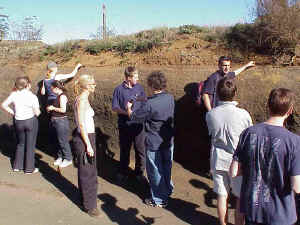Tectonic Activity and Hazards Field Studies in the Garrotxa Volcanic Park
The Garrotxa Volcanic Zone is situated 100 kilometres to the
north of Barcelona, an approximate road journey of two hours. It contains some
of the most interesting volcanic landscape in Europe. There are thirty
Strombolian volcanic cones, a few explosive phreatomagmatic craters, other
alternating Strombolian/explosive volcanoes and over twenty very unusually
constructed basaltic lava flows. In addition, the area's moist Mediterranean
mountain climate has contributed to lush vegetation and a spectacular landscape.
Moves to give the volcanic zone legal status go back as far as 1917 but it was not until 1975 that a serious conservation campaign won widespread support, culminating in protective legislation in 1982. A sharp rise in urbanisation and industrial development in the area had begun to affect the traditional rustic landscape. Volcanic craters were being used as civic refuse disposal sites and a particularly grave threat to the survival of some of the most interesting volcanoes was posed by cinder quarries taking material for use in building block manufacture.
Volcanism is of a basic type, involving basanitic and basaltic
lava. The last dated eruption occurred 11,500 years ago, thus though volcanic
activity has ceased, it cannot be considered to be finally extinct. The volcanic
eruptions varied greatly in intensity owing to the characteristics of the
substratum crossed by the vent and especially because the magma encountered
layers of water-saturated materials.
The thirty or so volcanic cones are in a very good state of natural conservation, considering their age. Most of the craters are visible and consist of cinder material: scoriae and lapilli with intervening layers of volcanic bombs. Pyroclastic hecciae are also visible, as well as cineritics and base surge deposits.
At the Fontfreda cliffs, river erosion has revealed magnificent prism-shaped columns while at Castellfollit, spectacular layers of lava from different lava flows are superimposed creating a spectacular cliff with the village sited at the top. At the 17,000 year-old El Croscat volcano, the lava mass has a rough surface covered with lava blocks and numerous blisters (projecting gas bubbles).
The field study course outlined below focuses on the nature and impact of the tectonic activity upon the Garrotxa landscape and the ways in which it has significantly affected the lives of the people who live there. Students use field observations to help understand and reconstruct the eruptive processes and visit a number of contrasting sites to investigate the benefits and costs of living in a volcanic environment. A selection from these options could be provided for a one-day visit, travelling from your accommodation in Barcelona.
| Day | Location | Time | Objectives | Activities | Main content |
|---|---|---|---|---|---|
| Day 1 Introduction | |||||
| 1 | Airport arrival and transfer to Santa Maria del Roure | ||||
| 1 | Castellfollit de la Roca | 2-3 hr | ● To observe and interpret the way in which
volcanoes have transformed the landscape. ● To reconstruct the lava flow emissions through the information provided by basalt outcrops. ● To examine the benefits and costs of living in a volcanic environment. |
● Annotated sketches of basalt outcrops. ● Visit town. Annotate map to show use of volcanic materials in its construction. ● Local quarry visit. |
● Interpretation of the geological history from the basalt outcrops. ● Use of volcanic materials. The quarry uses basalt in various industrial, domestic and decorative forms. |
| 1 | Classroom | 2 hr | ● Introduction to Plate Tectonics in the
Garrotxa Volcanic Park. ● Synthesis of information obtained during the fieldwork. |
● Images to show the Castellfollit de la Roca lava flow sequences. | |
| Day 2 Interpretation | |||||
| 2 | Montsacopa Volcano | 2 hrs | ● To understand the most common
type of volcanic activity the area. ● To formulate hypotheses about the Montsacopa eruptive activity. ● To reconstruct the Montsacopa eruptive processes. ● To examine how volcanoes are capable of transforming the landscape. ● To examine the benefits and costs of living in a volcanic environment. |
Interpretation of the landscape. | Type of eruptive activity: explosive and effusive. |
| Study of volcanic activity. | ● Interpretation of the volcanic deposits. ● Interpretation of the Garrotxa landscape. ● Volcanoes as transformers of the landscape. |
||||
| 2 | St. Joan les Fonts and El Boscarró | 2 hr |
● To reconstruct the lava flow emissions through the information provided by basalt outcrops. ● To examine the benefits and costs of living in a volcanic environment. |
● Interpretation of the geological history. ● Boscarró quarry visit. |
● Geological processes and landforms resulting from lava flow emissions. |
| 2 | Volcano Museum, Olot | 1 hr | ● To understand the Garrotxa volcanic processes and identify elements of the landscape. |
● Video: Garrotxa earthquakes and volcanoes. ● Geology: seismology and volcanism. |
● The impact of tectonics upon the environment. ● Consolidation of the fieldwork content. |
| 2 | Classroom | 2 hr |
● Synthesis of information obtained during the fieldwork. ● Evaluation of student reports. |
● Images to show the eruptive sequences of Montsacopa and St. Joan les Fonts. |
|
| Day 3 Investigation | |||||
| 3 | Classroom | ½ hr | Description of a volcanic outcrop. | ||
| 3 | La Pomareda and Croscat volcanoes | 4 hrs |
● To understand the geological history of the Garrotxa Volcanic Park. |
Interpretation of volcanic outcrops. |
● Interpretation of geological maps. |
| 3 | Fageda d'en Jordà | 2 hr | ● To reconstruct the eruptive activity of the
Croscat volcano through information provided by the lava flow emissions. ● To examine the benefits and costs of living in a volcanic environment. |
Interpretation of blisters (tossols). | ● Reconstruction of the Croscat eruptive activity and the type of volcanism. |
| 3 | Classroom | 2 hr | ● Evaluation of student reports. | ● Images to show the eruptive sequences of Pomareda and Croscat. |
|
| Day 4 Costs and Benefits | |||||
| 4 | Pedra Tosca Park | 2 hr | ● To examine the benefits and costs of living in a volcanic environment. | Interpretation of a volcanic landscape modified by humans. | ● EIA |
| 4 | Depart for airport | ||||
The objective is to apply a scientific method similar to that
utilised by vulcanologists to study the causes of the volcanic eruptions, the
anatomy of the volcano and the nature of the volcanic rocks.
- Form hypotheses about the stages in the formation of a volcano.
- Form hypotheses about the type of volcanic eruption that occurred.
- Relate the eruption and seismic activity in the area to geological map data.
The objective is to analyse the environmental impact of some of the human activities, the actions taken to restore the damaged environments, and produce a management plan for the Park.
- Introduction to the geological characteristics of the Park and the aims and values of the Natural Park.
- Assess the value of the Park's natural resources, and the environmental impact of both cinder extraction and refuse disposal sites.
- Study the restoration techniques used in the degraded sites.
- Draw up a management plan which resolves the environmental issues and problems of the Park.
- The social, economic and environmental effects of rural depopulation.
- The causes and effects of land use changes in hill farming.
- A case study of two contrasting villages, one declining, one growing and the implications for sustainable rural development.
- Soil Zonation: Brown Earths, Gleys and Podsols.
- Volcanic soils: rankers and volcanic sub-types.
- Hydrosere study (Banyoles).
